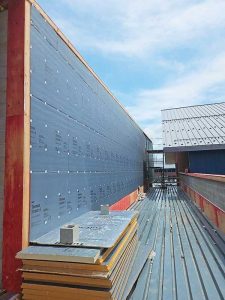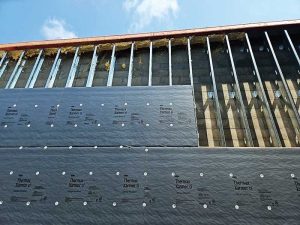
Upskilling the workforce
As the demand for energy-efficient and sustainable construction practices continues to grow, the need to hire and train the workforce is also urgent. When it comes to c.i., the workforce must not only understand the increasingly technical aspects of installation, but also the broader context of energy efficiency and sustainability. This understanding is vital to ensure the insulation is correctly applied to maximize its benefits and achieve increased energy performance.
Skilled insulation installers understand both the physical application of insulation materials and more elevated factors such as thermal bridging, air sealing, and moisture management. They can recognize the importance of proper detailing and how it impacts a building’s overall energy performance. As c.i. becomes more common, both builders and insulation contractors must invest in the following training programs to equip their workforce with sophisticated knowledge in:
- Technical expertise–Continuous insulation requires a deep understanding of various insulation materials, their properties, and their interaction with other building components. For instance, there are sequencing considerations that must be carefully coordinated because the timing of the work must align with other concurrent activities in the same location.
- Building science–Training should encompass the principles of building science, focusing on how insulation impacts the entire building envelope, including factors such as thermal performance, air leakage, and moisture control.
- Regulatory compliance–Given the evolving building codes and standards related to energy efficiency and sustainability, workforce upskilling is essential to ensure compliance with these regulations and avoid costly setbacks or legal issues.
- Technology integration–Continuous insulation often involves the use of new, emerging technologies and techniques. Keeping the workforce informed about these innovations can enhance a business’s competitiveness within the industry.
Skilled workers can ensure c.i. is applied effectively, minimizing energy waste and reducing operational costs for building owners. Proper insulation installation can also extend the life of a structure, saving money on maintenance and repairs over time—all added benefits to the customer. Further, it enhances the overall reputation of the construction industry, demonstrating its commitment to sustainable building practices. Finally, for the installers themselves, participation in comprehensive training programs gives them the opportunity for career growth and greater specialization.

Beyond energy efficiency
Innovations and advancements in c.i. continue to deliver substantial improvements in both residential and commercial projects. However, these innovations do not just enhance the energy efficiency of buildings, they also provide solutions that prioritize aesthetics, ease of installation, and overall effectiveness. The result is c.i. technology that is more accessible and practical.
Aesthetics
Traditionally, insulation materials have been concealed beneath interior finishes. However, new materials are designed to be exposed as part of the building’s aesthetic, leading to their development with appearance in mind. Innovations such as textured and visually appealing insulated panels or insulated brick facades can offer architects and designers greater flexibility in creating attractive and energy-efficient exteriors. This aligns with the growing trend of energy-efficient buildings that also prioritize curb appeal.




